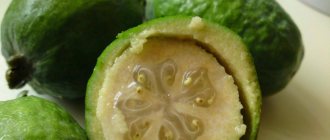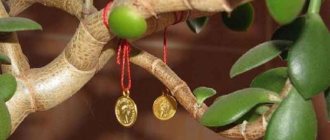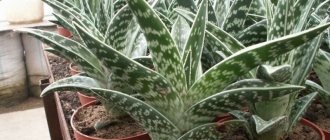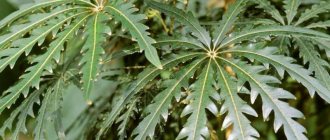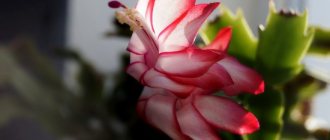What size container should be for planting aloe?
A properly selected pot for aloe will provide good conditions for plant growth. Home care in this case will consist of monitoring whether there is enough space for the plant in the pot. The calculation is simple: the length of the sheet and the diameter of the dish are equal to the ratio 2:1. The depth of the pot should be small. It is best to purchase ready-made soil, especially for succulents. The soil should not contain peat. Properly selected dishes will help ensure good care of the plant at home.
Plant transplant method
After the preparatory work has been completed, you can begin the main work. Considering the age of the plant and its size, it is advisable for the owner to know how to replant aloe at home. The procedure should be something like this:
- Take a plant and examine the rhizome. If it grows to the sides, then you need to choose a wide pot. If the rhizome grows downwards, then a deep bowl will be required.
- Pour a little earthen cushion into the prepared pot.
- Carefully take the plant and place it in a new container, adding a little soil to the sides.
After a few days the soil may become compacted and may need to be added a little bit at a time. Place the transplanted plant in the shade for about a week. Watering begins after five days. Only after this time has passed, the plant is transferred to a lighted place.
How fast does it grow?
The question of how quickly aloe grows worries many novice gardeners. The growth rate depends on the following factors:
- plant age;
- growing conditions;
- availability of nutrients in the soil;
- timely watering;
- sufficiency of light;
- pot size.
Reference. Aloe vera can also be grown outdoors. However, then it is necessary to ensure that the crop does not freeze. To do this, you can move it into an apartment for the winter or install a year-round greenhouse.
Aloe growth occurs gradually. It is necessary to replant the plant in a timely manner. It has another unofficial name - agave. This means that it grows for a really long time and can be inherited by the grower’s grandchildren.
Aloe propagation methods
There are several options for propagating this succulent. We choose a way to propagate aloe at home, for example:
- Radical shoots.
- Plant cuttings.
- Seeds.
- Upper shoots.
Reproduction by root shoots coincides with the planned transplantation of an adult plant. Using a sharp knife, you need to separate the shoot (it is also called “baby”) and place it in a glass of water for the roots to grow. It should take about two to four weeks for the shoot to take root. So, it's time to transplant it into a pot. Then all that remains is to follow the rules on how to grow aloe at home.
Propagation by cuttings involves using a very sharp knife to cut a leaf from an adult plant that has at least eight large leaves. The cut area should dry out a little. Treat the cut with ground activated carbon. This leaf needs to be stored outdoors for about a week. After the cutting site has completely dried, the cuttings can be planted in the ground. If there are a lot of cuttings, then they are planted in rows. Aloe cuttings can be carried out throughout the year.
Propagation by seeds is carried out in early spring, around March-April. You should first prepare small dishes and soil. The room temperature should be more than +20 °C. Water the soil in the container and spread out the seeds, cover it with a thin layer of sand, and cover the container with glass or film. It is necessary to provide watering and spray the emerging leaves in a timely manner. As soon as three true leaves appear, the seedlings need to be transplanted into other containers no more than five centimeters high. After a year, the grown plants are transplanted into larger containers. This is not the easiest method of propagation, but a large number of plants can be grown.
Reproduction by upper shoots occurs in the same way as by basal shoots. After cutting off the top with a sharp knife, the plant is dried for about three days. Then they are planted in wet sand to a depth of three to four centimeters. After rooting, they are transplanted into another container, and then they begin to grow aloe at home like any indoor plant, with love and care.
Composition for growing in a pot at home
The basis for the future soil is leaf soil. It is better to take it from under fruit trees; in extreme cases, maple and linden will do. To prepare the soil, the components are used in the following proportions:
- 2 parts leaf soil.
- 1 part river sand.
- 1 part humus.
A drainage layer is required. For this purpose it is used:
- expanded clay;
- small pebbles;
- brick chips;
- vermiculite
They are placed on the bottom of the pot in a layer of 2-3 cm.
The remaining soil components are laid out in the following sequence:
- Fertile soil.
- Sand (can be mixed with small pebbles).
To enrich the soil with nutrients, wood ash is used at the rate of 50 g of dry matter per 1 liter of mixture.
Important! To prevent diseases and pests, the soil mixture must be disinfected.
Disinfection methods:
- Heat in the oven at 180º for 15 minutes.
- Freezing for the winter (if you do not urgently need to plant the plant).
- Rinsing with a pink solution of potassium permanganate.
Aloe care
Experienced gardeners share some recommendations for caring for plants:
- It is necessary to organize proper watering of aloe at home. Watering is not done often. In summer, water moderately once a week. In cool weather, watering is reduced to twice a month. To avoid water stagnation, you need to use drainage, maintain a water temperature for irrigation of at least +25 °C, and be sure to use a tray with liquid.
- Regularly (from spring to autumn) feed the plant twice a month. Fertilizer for aloe should be specifically selected for succulents or cacti.
- Regularly spray the leaves of the plant and the air around them. Dry indoor air is very harmful to aloe.
- In winter, you need to try to ensure peace for the plant. Stop feeding, do not replant and water less.
- The room should be regularly ventilated, but without drafts.
- In the fall, be sure to carry out sanitary pruning. Removing dry and diseased leaves. Those leaves that have lost their bright color also need to be removed.
- Seed the plant regularly to avoid sprouts growing haphazardly in the pot.
- From time to time you can use complex mineral fertilizers for indoor crops. Excessive, unsystematic feeding can damage aloe.
- It is necessary to regularly and carefully inspect the young plant for the presence of harmful insects. Aloe can be affected by scale insects and spider mites. When the first signs of infection are detected, the plant must be treated immediately. For example, spray with a solution of laundry soap or a weak solution of vinegar. To completely free the plant from insects, it will be necessary to carry out repeated treatment with insecticides.
- No less dangerous pests for aloe are mealybugs and thrips. It is necessary to spray the plants with the biological product “Fitosporin”.
- Protect young plants from diseases. They can get fungal diseases. Dark green spots will appear on the plant. In this case, you will have to treat the plant with an antifungal agent.
These valuable recommendations from gardeners will tell you how to care for aloe at home.
Aloe vera is a plant that does not require particularly close attention to make caring for it at home a pleasure.
Growing problems, diseases and pests
The plant is rarely exposed to diseases, but sometimes aloe is attacked by harmful insects. Frequent flower pests:
- Scale insects are small insects, when they appear, small brown compactions form on the stem and leaves. To eliminate the problem, it is necessary to wash each sheet using a solution of laundry soap.
- Spider mite - this pest can be noticed by the formation of cobwebs on the leaves. The plant becomes weak and may dry out completely. It is recommended to wipe the affected areas with an alcohol solution.
With improper care, problems often arise that slow down the growth of a flower:
- The root collar rots - this problem occurs with frequent watering. To eliminate it, it is necessary to replant the crop and reduce the frequency of watering.
- The flower does not grow - most often the cause of the problem is clay soil. The plant should be transplanted into a new substrate with added sand.
- Yellow leaves are a sign of excess fertilizer. To solve the problem, the frequency of fertilizing is reduced to once every 3-4 months.
Growing aloe tiger does not require much effort. The crop is undemanding in watering and does not require pruning. Aloe leaves have medicinal properties and are often used for cosmetic purposes and folk recipes.
The healing properties of aloe juice
Aloe juice is extremely beneficial. They treat inflammatory diseases of the skin. It copes well with a runny nose. Extracts from the plant are used in the production of cosmetic products. People have always known the beneficial properties of aloe:
- Bactericidal - in the treatment of purulent wounds, calluses, burns and other skin problems, a compress of pulp is used.
- Laxative and choleretic - treatment with aloe juice increases appetite, improves peristalsis, and restores the functioning of the pancreas.
- Anti-inflammatory - aloe juice is used in the treatment of gastritis and infectious diseases.
It must be remembered that taking aloe juice without a doctor’s recommendation is extremely unsafe. Freshly prepared juice cannot be stored.
Description of aloe vera flower
A bush with a short stem - this is what a flower looks like in nature. Its root system is poorly developed. The leaves are directed upward and have a fleshy structure, with thorns along the edges, and are able to retain moisture for a long time. The leaf width reaches approximately 15 centimeters, and the leaf length ranges from 60 to 100 centimeters. The leaf color is bright and rich. The color of the leaf can have two options: green and blue-green.
15 plant species are medicinal. Among them, aloe vera is considered especially popular.
Aloe vera has several names, namely: aloe Barbados, also known as real aloe. Barbados is the birthplace of this most valuable flower. As a houseplant, aloe vera is grown much less frequently than the tree plant.
The most valuable component is the unique aloe vera juice. No less useful is the gel-like mass that is located inside the sheet. In cosmetology, pulp and juice are widely used. Gels, scrubs, and masks are prepared from it.
The most studied succulent turned out to be aloe vera; its medicinal properties and uses have been known for a very long time and have been thoroughly studied. It is actively used in folk medicine, pharmacology, perfumery, and cosmetology. This flower is considered the most unpretentious indoor plant.
You just need to know how to grow aloe vera at home and organize proper care for the plant.
Important! You need to know that when growing a flower for medicinal purposes or cosmetic procedures, you should not use complex mineral fertilizers.
It is necessary to grow aloe vera in well-lit rooms, periodically turning the succulent on different sides towards daylight to avoid bending of the stem.
Interesting Facts
This plant is not only elegant and beautiful, it brings great benefits. In the room where the flower is located, the air is purified, it becomes much easier to breathe, and the health of the inhabitants of the house improves, troubles and sorrows recede.
Aloe is able to protect the residents of the apartment where it grows from failures, troubles and ailments. If a sick person hangs agave leaves around his neck in a bag, the disease will soon recede. The flower is believed to attract love. A girl who wants to get married quickly can speed up what she wants by performing the following ritual:
- it is necessary to carefully cut 13 leaves from the plant, after asking its forgiveness;
- the leaves are placed in a dark, dry place for 13 days;
- They burn dry leaves and scatter the ashes near the threshold of their apartment.
Having completed the ritual, there is no doubt about the speedy result.
Special aloe vera flower
What is unique and useful about the aloe succulent? Caring for a growing plant at home allows you to always have an assistant in the fight against germs, fungi and bacteria.
Aloe vera has an antibacterial and disinfectant effect. You just need to apply the gel to your palms and rub. Germs and dirt will be destroyed by the plant sap.
You can use aloe vera succulent as an effective vegetable and fruit wash, it is a true natural product without chemicals.
Aloe vera flower is rightfully considered a natural analgesic and the first aid for skin damage.
Indoor aloe
You can grow aloe at home as an ornamental plant or just to decorate a room. For example:
- Aloe variegated (striped, tiger). Externally, the plant is very similar to a small tree.
- Aloe marlote. It is a succulent with large and wide leaves. There are red thorns on the leaves.
- Aloe squat. A small plant, perennial, the leaves are grey-green or grey-blue with many spines.
- Aloe whiteflower. A rare flowering plant without a stem, the flowers resemble lilies.
Indoor succulents do not produce seeds, their peduncles are much shorter, and their flowers are smaller. When the plant fades, the arrow must be removed. Growing aloe at home (both decorative and medicinal) is not difficult.

